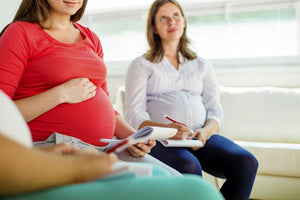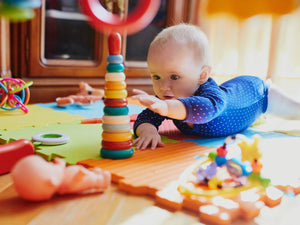Group B Strep (GBS) has been around for a very long time. But like so much in the area of obstetric care, we continue to understand more about it.
Most of us carry this bacterium in our gut but in around 15-30% of women, GBS also colonises their vagina. This can create problems during pregnancy because GBS can make microscopic (very small) holes in the amniotic sac and infect the baby through the amniotic fluid. Around 7% of women with GBS develop an infection of the amniotic sac, otherwise known as chorionamnionitis.
Babies who are infected with GBS can develop a condition known as early onset group B streptococcus disease (EOGBSD). This affects around one baby in every 1000. Babies infected with GBS can develop sepsis – a widespread infection which can lead to pneumonia and meningitis.
How Would I know if I have GBS?
You probably wouldn’t know unless you have a vaginal or rectal swab. There are generally no symptoms of GBS, which can be difficult to detect and doesn’t show any obvious symptoms. Sometimes GBS can cause a urinary tract infection (UTI) but not all women with a UTI have symptoms.
Screening for GBS
Currently in Australia, all pregnant women should be offered a screening test for GBS. However, many maternity hospitals don’t recommend routine screening for GBS; it really depends on the individual maternity care provider and/or the maternity hospital involved.
If screening for GBS is offered, ideally it’s done as close to the birth as possible, generally between 35-37 weeks. The swab should be taken from the lower vagina and rectal area. Either the mother or her maternity care provider takes the swab which is then sent to pathology for testing.
The point of swabbing antenatally is to detect if a mother is a carrier of GBS and predicts the risk to the baby of being infected with GBS during labour.
Remember!
A positive result for GBS is only reliable for the following five weeks. The screening itself is not perfect and only detects around 95% of cases.
What if I’m not offered a test for GBS?
In some states, there is general agreement that the best way to prevent the transfer of GBS from a mother to her baby is to give antibiotics to mothers who are at risk.
You can always request a GBS test if you’d prefer.
Is my baby at risk of being Exposed to GBS?
Risk Factors include:
- A mother being tested as positive for GBS during her current pregnancy.
- A mother testing positive for GBS bacteriuria (UTI) during her current pregnancy.
- A mother having an elevated temperature of 38 degrees Celsius (or higher) during labour.
- Ruptured membranes for longer than 18 hours during labour.
- Prolonged labour.
- Changes in the baby’s heart rate during the first stage of labour.
- If the mother has gestational diabetes.
- If the baby is born premature e.g. before 37 weeks gestation.
- If a mother has previously had a baby with EOGBSD.
How would GBS affect my baby?
Around 80% of GBS infections are early onset, which means they are present just before or at birth. Statistically, around 18% of premature babies who develop an early GBS infection will die and around 6% of babies born at full term die.
If a mother tests positive for GBS, there is an extremely small chance that the baby could develop a blood infection, pneumonia or meningitis. Very sick babies can die because of EOGBSD. The majority of babies with EOGBSD develop the infection in the first 24 hours after they are born. Late onset of GBS infection can also occur, generally between 7- 90 days after birth.
Babies, who do survive, in particular those who develop meningitis, may go on to have long term problems. Hearing or vision loss and learning disabilities are the most common.
How Would I Know if my Baby has GBS?
Around 80% of GBS infections are what is known as “early onset”. This means they are seen at or shortly after birth. Premature babies with early onset GBS are at particularly risk though the incidence for full term babies is still high.
What is the Treatment for GBS?
Treatment for GBS starts at the onset of the mother’s labour. Intravenous antibiotics are given which helps to reduce the risk of early GBS infection in babies. Ideally, antibiotics are given four hours before birth and four hourly after the first dose. Antibiotics for both a mother and her baby are generally administered via an intravenous drip.
Research into the effectiveness of antibiotics has shown some interesting results. It seems that treatment does not have any effect on reducing the number of newborn deaths from GBS infection. There are also some risk factors associated with antibiotic therapy, especially the reduction of healthy or “good” bacteria in the mother and baby’s gut.
References
This article was written for Nourish by Jane Barry, midwife and child health nurse.
Our Products
-

01. Guide to a Healthy Pregnancy
$55 -

02. Positive Birthing Course
$55 -

03. Infant Feeding Guide
$55 -

04. Baby Sleep Guide - First 12 Months
$55 -

05. Toddler Parenting Course 1 - 3 Years
$55
-
 When to Start Antenatal Classes?
When to Start Antenatal Classes?
Becoming a parent is an incredible milestone, but it comes with a host of changes that can be daunting, especially for first time parents. Antenatal classes are all about offering expectant parents the education they need to make informed decisions, look after their bodies and care for their newborn babies. While you probably already have a long list of things you need to accomplish during your pregnancy, it’s a good idea to make time to attend antenatal classes.
-
 Development Milestones 4-8 Months
Development Milestones 4-8 Months
As they reach the middle of their first year, you'll start to see bigger leaps in their growth and ability!
In this article, we’re going to discuss your baby’s developmental milestones between 4-8 months, and what you can expect along the way.





 When to Start Antenatal Classes?
When to Start Antenatal Classes?
 Development Milestones 4-8 Months
Development Milestones 4-8 Months








